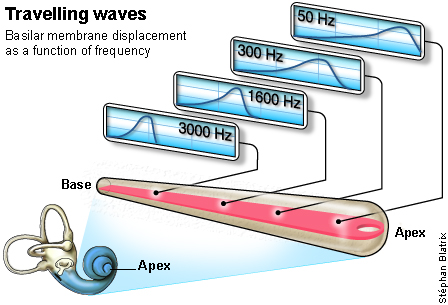| Overview / Physics / Fluids / Stria | |
| Drawing : S. Blatrix |
| Overview / Physics / Fluids / Stria | |
| Drawing : S. Blatrix |
| Propagation of
sound waves into the cochlea: resonance and/or travelling waves? |
|
The ossicular chain ensures the
transmission of acoustic pressure from the air to the cochlear
fluids (see
animation). For more than a century, the physical mechanisms
explaining the propagation of signal and the tonotopic pattern
of the cochlea have been explained by two main theories, namely:
resonance or travelling waves. |
| In 1863, Helmholtz (ref. b1) described the cochlea as being formed of basic elements, each one resonating at a different frequency, like the strings of a harp. |
| In the late 1930s, Békésy (ref. b2) developed the travelling wave theory, for which he was rewarded the Nobel prize in 1961. | |
 |
|
|
As shown in this schematic drawing, as the frequency varies from high to low, the site of maximum displacement of the basilar membrane shifts toward the apex. This corresponds to a passive tonotopy . |
| Because of the discovery of the outer hair cell (OHC) active mechanism which explains the exquisite properties of sensitivity and tuning of the cochlea, the travelling wave versus resonance theory is not a hot debate any longer. Most acousticians and physiologists now think that the physical model of damping resonance, based upon OHC properties, is close to reality; the travelling wave tends now to be considered an epiphenomenon. |
 |
For
permission to non-commercial use of any element of this site, please contact us All rights reserved © 1999 - 2007 The authors Intellectual property law 85-660 (07/03/1985) |
|